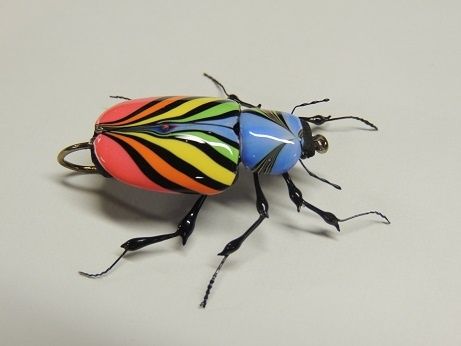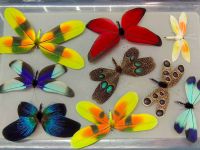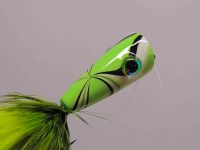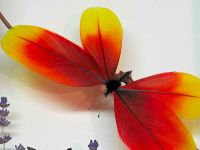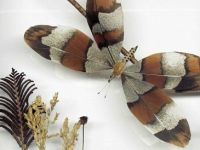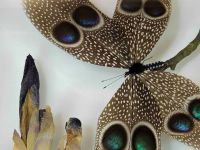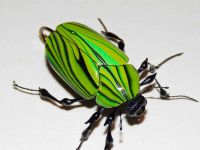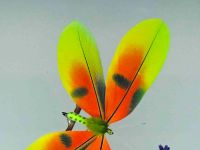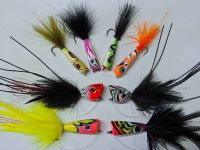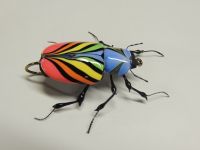Fd: How did you first get into fly fishing and tying?
Scott: I was introduced to fly fishing after taking a one day seminar at LL Bean in Freeport, Maine. I was looking for something different to try, and had never fly fished before, so I decided to take the class. That was about 12 years ago now. The fly tying aspect was, for me, almost an afterthought. After the class, on my way out of the store, I decided to pick up a basic fly tying kit, just to see if I’d like it.
As the cashier was checking me out, she saw the kit and paused. She looked up at me and raised an eyebrow. “Are you sure you want to get this?” she asked. “Fly tying is very addictive. Once you start, you won’t want to stop.” I was tired from the day. I half smiled at her, and only offered back a weak “We’ll see,” having no idea just how right she would prove to be. I was hooked with the first wrap of thread, and I haven’t looked back since.
Fd: Is there a reason why you specialized on realistic butterfly patterns? What were you fishing for those days?
Scott: Actually, my butterfly pattern has nothing to do with fishing, believe it or not. I live in the woods in Northeastern Pennsylvania, and I have two daughters. When they were younger, we spent the majority of our summers chasing and catching butterflies in our back yard. We were fascinated by them and even raised several species. At the time, I had been tying for a few years, and like most fly tiers, I had amassed quite a collection of feathers. My tying room was filled with all sorts of beautifully patterned feathers, stuff I needed to have whether I had a use for them or not.
One day, as my girls and I were feeding a batch of painted lady butterflies we had raised, it occurred to me that their wings looked an awful lot like some of the feathers in my collection. That night I started playing around at the vice, and after some trial and error, I developed my butterfly pattern.
Fd: Do you have any stories from your clients fishing with the butterfly patterns?
Scott: I’ve never actually fished one of my butterflies, but since I’ve had them I usually get at least one story at each show I do from someone who has seen a fish take a wounded butterfly or moth that has fallen onto the water. At some point I do want to throw one on the stream, just to see what happens.
Fd: What other type of flies do you enjoy tying?
Scott: I’ll tie any and everything. I do enjoy the creativity that fly tying affords, and I often think outside the box to try to stretch the creative limits of the craft. My water marbled beetles are a good example of this. I’ve created museum quality flies and displays for various organizations as well, including a replica of a section of the Brodhead stream in Pennsylvania complete with historical replications of flies developed to fish that area. I enjoyed that project very much.
Some of my favorite orders to fill are those from customers who ask for 6 to 12 flies of a variety of patterns that aren’t necessarily mainstream patterns but fish well nonetheless. The only thing I shy away from is production tying. I do need to vary what I tie, and the thought of trying to tie 20 dozen Adams flies is not a pleasant one for me. I have a ton of respect for my fellow tiers out there who have the mental fortitude to tackle such a task, it’s something I think I couldn’t do.
Fd: What are your thoughts on the future of fly tying and the new kinds of materials?
Scott: I really look forward to seeing the craft advance and move forward. When it comes to materials, it’s all fair game, and I very much enjoy the innovative products that my fellow tiers continue to create and promote. There are lot of creative, resourceful, and innovative people in this industry, and I think we all encourage each other and push each other forward. It’s a great group to be a part of, and I hope I can continue to contribute to the craft the way my colleagues do.
Fd: What are your main influences when creating patterns?
Scott: I find that, as a fly tier, you start looking at the world a little differently. Everything is fly tying material, it’s all fair game, and I spend probably too much time trying to figure out how I can make everything look like a bug. I find that’s what drives and influences me the most, that outside the box type of thinking that I try to foster in myself.
I’ve tied a grasshopper in flight, with wings spread. Nothing seemed to work as sufficient wing veins until one day, while getting my haircut, I realized that my hair clippings were just the right diameter to replicate the veins. So I incorporated them into the wings, with good results. In the same vein, after crossing paths with someone wearing acrylic nails, I realized that the shape of those fingernails bore a remarkable resemblance to a beetle shell. Once I created my beetle pattern with those acrylic nails, I decided to experiment with water marbling them (a high-end manicure procedure,) which helped me create some very striking and unique shell patterns. I’ve since adopted that technique to popper painting to create some very unique bass flies as well.
I apply that same thought process to the products I create, too. While preparing for a yard sale, I pulled an old beat up chess set from the bottom of a closet. Wouldn’t it be neat, I thought, to create a chess set where the pieces were flies? I’ve since made several chess sets, and they have proven to be one of my most unique products. It’s this kind of thought process that I find drives and influences me. I think our creativity is only limited by the limits we impose on ourselves. Remove the limits, and suddenly your options are wide open.
Fd: What other tips can you give to the tiers out there?
Scott: I would just reinforce what I said above: think outside the box, look at things from unique perspectives, and remember the only limits you have are those you place on yourself. Thank you for giving me the opportunity to be able to share my thoughts and my work.
For more about Scott and his flies, please visit scottcesariflytying.com


